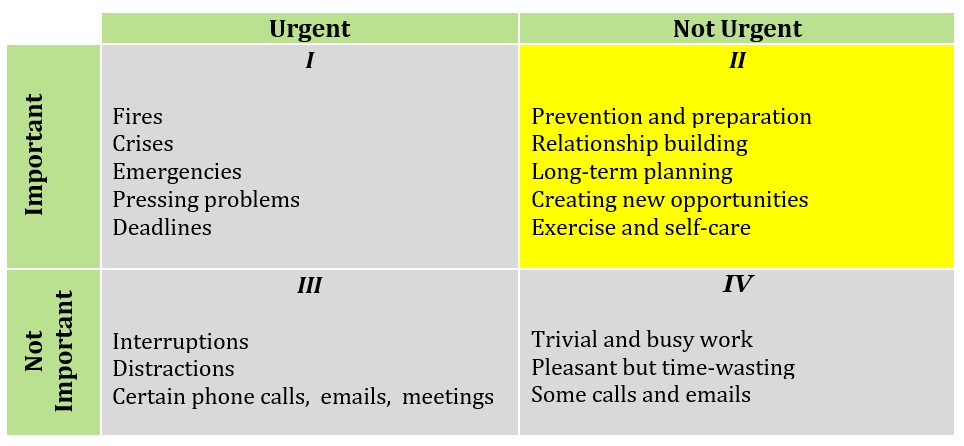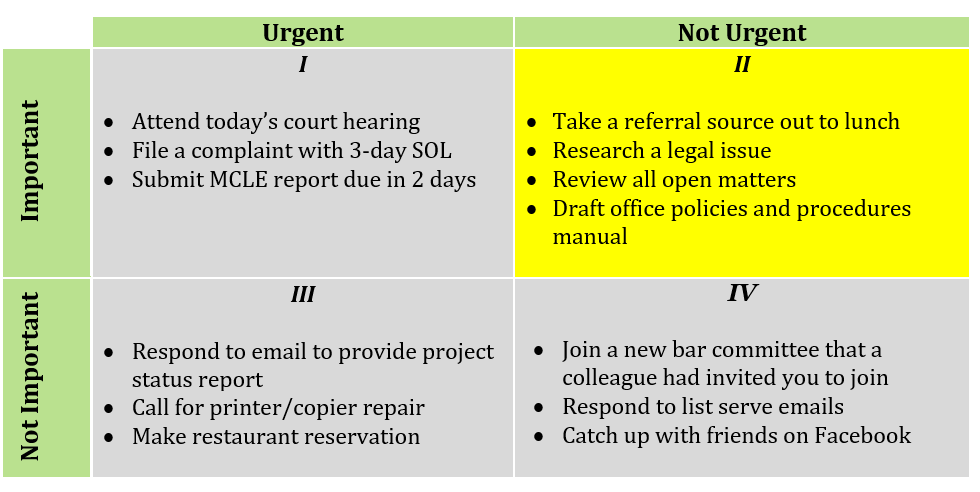At the beginning of 2017, I wrote a blog post on using the 80/20 Pareto Principle to manage your time. I start this year with a similar post on time management. For this post, I turn to Habit 3 of Stephen Covey’s book, The 7 Habits of Highly Effective People, to help lawyers see time management from another perspective.
What Does Stephen Covey Say about Time Management?
In his chapter on Habit 3, Covey argues that time management is really about managing ourselves. Habit 3 is about putting “first things first.” This means prioritizing our actions based on what is most important. So rather than focusing on allocating time to each task on our to-do list, it’s about prioritizing activities that preserve and enhance relationships with others and bring us closer to our ultimate goals and desired outcomes.To help us evaluate the priority of our tasks, Covey lays out a two-by-two matrix labeled Urgent, Not Urgent at the top and Important, Not Important on the side. Every task or activity is defined by urgency and importance. Urgency requires immediate attention. But just because a matter is urgent doesn’t mean it’s also important. Importance is about results. Important activities contribute to our mission, values, and long-term goals. Below is an illustration of the matrix with some activities that characterize each quadrant.

Covey argues that most people spend a large portion of their time in Quadrant I (urgent and important) putting out fires, responding to crises, or solving pressing problems. They often end up feeling stressed and burned out. Their relief is to escape to the unimportant and non-urgent activities in Quadrant IV that may be pleasurable but waste time. People who spend their time in Quadrant III are distracted by external demands and find their day constantly interrupted by phone calls, emails, and meetings.
People respond faster to urgency than to importance. Urgency gets their attention and makes them busy. Important but non-urgent tasks, on the other hand, are sometimes the hardest to perform because they require planning and deep thinking. As a result, many people ignore activities in Quadrant II. But it’s Quadrant II that we should focus on. Covey writes:
While we can’t ignore the important and urgent matters in Quadrant I, they will shrink in size when we spend time planning, preparing, and engaging in preventative and future-looking activities in Quadrant II. That requires spending less time in the unimportant quadrants. It’s learning to minimize, eliminate, and say no to activities in Quadrants III and IV. This will free up time for Quadrant II activities.
How Can Lawyers Benefit from Using the Time Management Matrix?
Covey’s time management matrix helps put lawyers’ activities in perspective. Some activities produce results and move you closer to your goals (e.g., the 20% in the Pareto Principle), and other tasks move you further away because they waste your time and energy (e.g., the other 80%). Using the matrix, lawyers can prioritize their time by assigning each activity to a quadrant and choosing what to focus on first.Let’s look at a list of sample activities in one given week and decide whether each item is important or urgent. Remember, important tasks bring you closer to your goals or the mission of your law practice, which probably involves providing quality legal services to clients and growing and sustaining your firm.
- Take a referral source out to lunch
- Research a legal issue
- Attend today’s court hearing
- Review all open matters
- File a complaint with a statute of limitations expiring in three days
- Submit MCLE report due in two days
- Join a new bar committee that a colleague had invited you to join
- Respond to list serve emails
- Catch up with friends on Facebook
- Call a restaurant to reserve a table for staff appreciation luncheon tomorrow
- Draft office policies and procedures manual
- Call repair person to fix printer/copier in office
- Respond to email asking for a status report of your projects for tomorrow’s meeting
Below is what the activities look like when placed in the matrix and applying Covey’s principles.

Based on the guidelines provided by Covey, this is how you might approach the activities in each quadrant.
- Quadrant I (urgent and important) – Do these activities first. Reduce last minute-activities (e.g., filing complaint and submitting MCLE credit) by planning ahead and avoiding procrastination. Be flexible in your schedule to deal with unexpected emergencies.
- Quadrant II (not urgent, important) – Prioritize, plan, and execute around priorities in this quadrant. Schedule time to perform each activity so they don’t fall on the back burner.
- Quadrant III (urgent, not important) – Delegate as many activities as you can (e.g., call for repair service, make reservation). Try to minimize as many of these activities as possible.
- Quadrant IV (not urgent, not important) – Learn to reduce or eliminate these activities. Be careful about saying yes to activities in this quadrant because they may lead to busy work (e.g., joining a committee).
For some lawyers, it’s difficult to stop doing the activities in Quadrants III and IV right away, let alone stop doing them entirely. In that case, it might be better to perform important activities in Quadrants I and II when you have the most energy and are most clearheaded. As your cerebral power decreases throughout the day, then you can do the less important tasks.
As Covey mentions, managing time is about managing ourselves. That means knowing who you are, when you’re most productive, and when you’re not. If you’re most productive in the morning and hit a slump after 3 p.m., then schedule the late afternoon for activities from Quadrants III or IV. If you can focus for only two hours at a time, then schedule a 15-minute break every two hours for Quadrants III and IV tasks. Otherwise, the unimportant activities will monopolize your entire day without your even knowing it.
As you learn to prioritize each task, you will become better at saying no to unimportant activities, whether urgent or not, and saying yes to important activities in Quadrant II.


















_dragonwithlaptop1681501312-18359.jpg)



